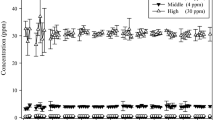Summary
Fifteen exposure experiments were carried out, in which four persons each, were simultaneously exposed to a defined concentration of o-, m-, and p-xylene vapors and also to their mixture at a ratio of 1:1:1. The concentrations were in all cases around 0.2 mg/l (Czechoslovakian MAC) or around double the amount. The period of exposure amounted to exactly 8 h.
It was ascertained that the pulmonary retention is practically identical in all persons and in all isomers and amounts to 63.6 ± 4.2%. Its extent does not depend upon inoculation level, nor upon the duration of the exposure. During the period of desaturation the lungs excrete approximately 5% of the total amount retained in the organism. Xylene excretion via urine is quite negligible and amounts to a thousandth of 1%.
The chief metabolites are toluic acids which are excreted in conjugated form with glycine as so-called toluric (=methylhippuric) acids. Free toluic acids, toluylglucuronic acids, and hydroxytoluic acids do not occur in the urine of persons exposed to a reasonable concentration of xylene vapors.
The excreted amounts of toluric acids reach a maximum in the portion of urine collected at the end of exposure; then they decrease rapidly, but trace amounts can be still observed even after 4–5 days. The excretion takes a similar course in different persons and at different intensity of exposure. During the last 2 h of exposure a mean of 23.6% is excreted and in 8 h of exposure 71.7% of the amount excreted within 24 h.
The side metabolites of xylenes are compounds hydroxylated on the aromatic nucleus. After exposure to o-xylene the presence of 2.3- and 3.4-xylenol was observed in urine; after exposure to m-xylene the presence of 2.4 xylenol, and finally after exposure to p-xylene the presence of 2.5-xylenol. The excretion of xylenols reaches a maximum as a rule just after termination of exposure.
It was proved by balance calculation that of the total amount of xylene retained in the organism during exposure, more than 95% is excreted in the form of toluric acid (o-97.1; m-99.2; p-95.1%) and only a small part in form of xylenol (o-0.86; m-1.98; p-0.05%).
Similar content being viewed by others
References
Bakke, O.M., Scheline, R.R.: Hydroxylation of aromatic hydrocarbons in the rat. Toxicol.appl.Pharmacol. 16, 691 (1970)
Bray, H.G., Humpris, B.G., Thorpe, W.V.: Metabolism of derivatives of toluene. 3. o-, m- and p-xylenes. Biochem.J. 45, 241 (1949)
Bray, H.G., Humpris, B.G., Thorpe, W.V.: Metabolism of derivatives of toluene. 5. The fate of the xylenols in the rabbit, with further observations on the metabolism of the xylenes. Biochem.J. 47, 395 (1950)
Daly, J.W., Jerina, D.M., Witkop, B.: Arene oxides and the NIH shift: The metabolism, toxicity and carcinogenity of aromatic compounds. Experientia 28, 1129 (1972)
Fabre, R., Truhaut, R., Laham, S.: Recherches sur le metabolisme comparé des xylénes ou dimethylbenzénes. Arch.Mal.prof. 21, 314 (1960)
Flek, J., Šedivec, V.: Determination of toxic substances and their metabolites in biological fluids by gas chromatography. VII. Toluric or toluic acids in urine. Coll.Czechoslov.Chem.Commun. 38, 1754 (1973)
Kaubisch, N., Daly, J.W., Jerina, D.M.: Arene oxides as intermediates in the oxidative metabolism of aromatic compounds. Isomerization of methyl-substituted arene oxides. Biochemistry 11, 3080 (1972)
Ogata, M., Tomokuni, K., Takatsuka, Y.: Urinary excretion of hippuric acid and m- or p-methylhippuric acid in the urine of persons exposed to vapours of toluene and m- or p-xylene as a test of exposure. Brit.J. industr.Med. 27, 43 (1970)
Pagnotto, L.D., Lieberman, L.M.: Urinary hippuric acid excretion as an index of toluene exposure. Amer.industr.Hyg.Ass.J. 28, 129 (1967)
Šedivec, V., Flek, J.: Bestimmung toxischer Substanzen und ihrer Metaboliten in biologischen Flüssigkeiten mittels der Gaschromatographie. V. Hippursäure in Urin. Coll.Czechoslov.Chem.Commun. 35, 3265 (1970)
Šedivec, V., Flek, J.: Bestimmung toxischer Substanzen und ihrer Metaboliten in biologischen Flussigkeiten mittels der Gaschromatographie. II. Phenol und p-Kresol in Urin. Coll.Czechoslov.Chem.Commun. 35, 242 (1970)
Sedivec, V., Flek, J., Mráz, M.: Preparation of an atmosphere with defined contents of studied substances (in Czech., English summary). Pracovní Lekařství 26, 48 (1974)
Srbová, J., Teisinger, J.: Absorption and elimination of toluene in man (in Czech., English summary). Pracovní Lekařství 4, 41 (1952)
Author information
Authors and Affiliations
Rights and permissions
About this article
Cite this article
Šedivec, V., Flek, J. The absorption, metabolism, and excretion of xylenes in man. Int. Arch Occup Environ Heath 37, 205–217 (1976). https://doi.org/10.1007/BF00378419
Received:
Accepted:
Issue Date:
DOI: https://doi.org/10.1007/BF00378419




